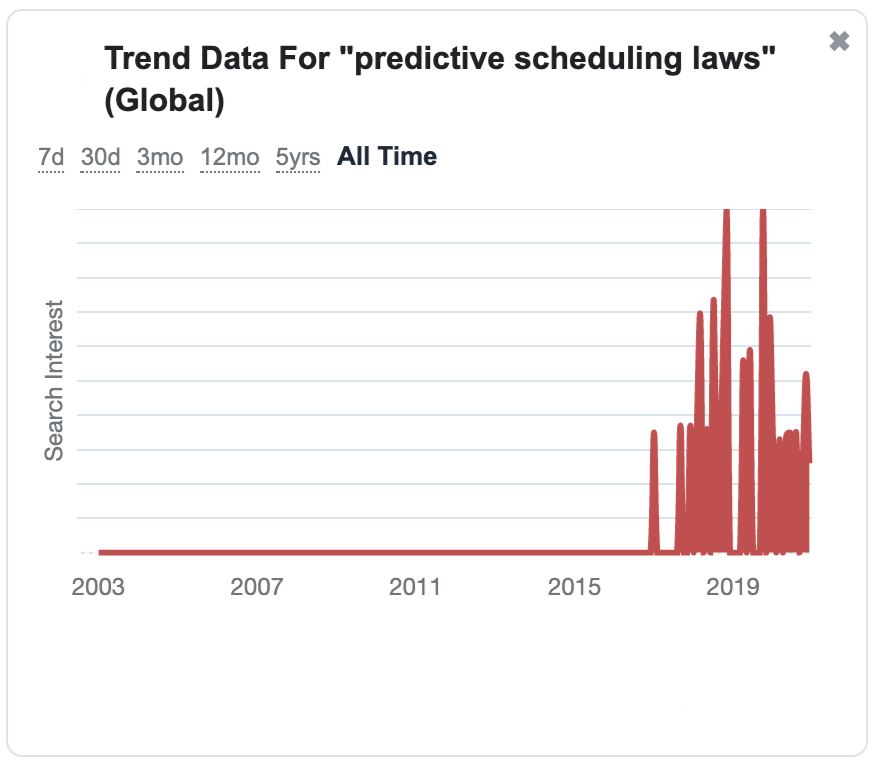5 Ways to Schedule Compliance & Happier Employees!
Improving your employees work-lives while keeping the suits happy
Too Long, Didn’t Read.
What is Digital Wage Theft?
Predictive Scheduling, What is it?
5 Scheduling Policies to adopt.
In The News.
🥱 The TL;DR
Lawmakers across the US and Canada are rapidly adding Predictive Scheduling ordinances to labour laws in response to work schedule uncertainty issues which have been receiving increased media and political attention in recent years. In this article, I suggest 5 scheduling policies that will increase your compliance with these types of laws (regardless of the jurisdiction you operate in) and actually improve your employees’ work lives.
🔭 Predictive Scheduling, What is it?
It isn’t anecdotal to say Predictive Scheduling has become an increasingly important topic within Workforce Management and Labor Operations circles. I have witnessed this firsthand with some of my clients. The ones particularly affected are those with large hourly workforces in Retail, Fast Food, Tourism and other related service sectors, though I am sure HR Execs and their General Counsel across all industries are keeping a keen eye on this too.
The term Predictive Scheduling confuses people at times. They mistake this with the common practice of creating employee Schedules based on demand forecasts. Predictive in this case is from the employees’ perspective i.e. the employee being able to anticipate what their upcoming schedule will look like. As such you’ll sometimes hear Predictive Scheduling ordinances also called “Fair Workweek”, or “Secure Scheduling” laws. So the laws are coming, and for some, they are already here, these are 5 scheduling policies you can adopt no matter where you operate to increase compliance and improve how your employees feel about coming into work.
⛔️ Policy Change 1: Absolutely No Clopens
If you’re fortunate enough to not know what a “Clopen” is, it is when an employee is scheduled the closing shift as well as the next opening shift back to back. Meaning by the time the employee has ended their day they will be required back into work with barely a few hours of rest in between.
Anyone who has worked in the Retail, Fast Food or Services industries knows how terrible these are. I have worked my fair share of clopens in a prior life as Barrister and always almost quit during them seriously contemplating my life journey to that predicament as I opened the cafe that morning.
So, be clear with your frontline Managers and Supervisor-absolutely no clopens. Some States, Counties and Provinces will have fatigue management laws that may allow clopens if there are at least 9 or 10 hours in between the shifts. Avoid the temptation of threading that line. No Clopens!
🤝 Policy 2: Incorporate Employee Schedule Preferences
It has been interesting to observe how the Customer become something of an obsession to the corporate strategists with customer profiles, voice of customer surveys and endless frameworks and analysis. Where is the same energy to attempt to understand your employees, profiling them and having their voice present during corporate strategy development? The employers who care about their employees enough to get it truly have a competitive advantage in their people, after all, labour costs are only the largest line item on every businesses P&L. I digress!
At the very least, talk to them, understand their life events and offer them a means to control some aspects of their work schedules, and this can be done in a variety of ways, the top 3 would be:
Allowing them to set Available or/and Non Available times they can or can not be scheduled to work.
Granting them the ability to choose preferred shifts.
Permitting them to swap or trade shifts.
📆 Policy 3: Schedule Posting Notice
Take the long view of your scheduling process and provide more than adequate notice of work schedules to your people. About 14 years ago, I was leading scheduling operations at Ikea Canada and we were giving our employees at least 14 days notice of schedules. We did this in the face of the prevailing norm, “just in time scheduling” as it was called back then and just did what we thought was fair for our people. Our Employee SAT scores jumped as well as every other productivity measure we tracked. It was the first time I had seen firsthand that taking care of worker is great business practice and to this day I am proud to have worked for IKEA and in particular those Execs whose lessons I carry with me.
Today, the majority of the passed ordinances call for 14 day posting notice. I would suggest 21 days to cover you across all jurisdictions. If your inner voice is doubting the efficacy of this consider that the majority of European hourly workers receive their schedules 9 to 12 months out and tell that voice to shut up! Do it for your employees, the parents and students in your ranks will thank you.
🙅♀️ Policy 4: Right to Decline
This one is simple. Allow your employees the right to decline shifts offered as well as schedule changes made on short notice. Be reasonable with your definition of what short notice is. Scheduling ordinances vary on this one calling for between 48 and 72 hours, so I would suggest the latter or longer.
To make Right-to-Decline work you’ll need to understand your work culture and keep an eye out for supervisors or Managers who behind the veil may be reprimanding employees that turn down their short notice shifts.
Most decent Workforce Management solutions today will allow to keep a record of incidences in which schedules change, shifts are offered, accepted or rejected. Take advantage of this tech and capture the causes of scheduling changes as well as which shifts (dates and times) are normally impacted. There are useful insights to be drawn from such data. The evolution of Scheduling and Timekeeping KPI’s is a topic I’ll be getting into in the near future, if you haven’t yet, subscribe to not miss it.
💰 5: Pay Schedule Change Premiums
Lastly and probably most important to enforce these changes, pay additional compensation for any schedule changes made by your managers/supervisors after the schedule has been posted. You could vary the premium rates on how close the proposed workday is to the day the change is requested. For example, you could pay two and a half times for shifts in which 48 hours or less advance notice is given, double-time for a week to 48hrs notice and time and a half for two and half week to a week notice.
I’ve had some Executives look at me screw faced and ask me to convince them why they should burn valuable payroll dollars on a policy such as this and my response:
Send a strong message to your Managers and Supervisors that employee wellbeing is a priority and the organization is putting it’s money where it’s mouth is.
The premium will become a key metric by which you can measure how well executed your Departments scheduling processes are against one another, as well as a measure of how well the Manager/Supervisor is managing your most valuable resource.
Depending on the maturity of your current scheduling process, you may already be paying this as a hidden premium in the form of excessive overtime, turnover and costs of talent acquisition and training. Lord forbid if you are in a state or province that already has these ordinances and the suits catch you, then you’ll pay for it in a different kind of way!
Lastly, these types of laws if not already passed where you operate, will be soon coming your way. So why not get ahead of them and get acclimated before you’re forced to change. Adopting such policies ahead of the labour law changing may even give you a competitive advantage in this very tight labour market and position you as the progressive and preferred employer of choice against your competition.
Looking back at them squarely in the eye and seeing their wheels crank as they consider what I have put before them gives me so much pleasure! Especially when they visualize for themselves how such policies will improve their employees time at work as well optimize the payroll spend it is the ultimate win-win!
📺 In the News
Is 'predictive scheduling' Colorado's next workplace regulation battle? - Ed Sealover for The Denver Business Journal, January 18, 2022
New Oregon Labor and Employment Laws for 2022 - Holland & Knight for lexology.com, January 10 2022.
Chipotle owes workers $150M after violating NYC scheduling law, city says - Katie Clarey for hrdrive.com, May 7 2021
Employers grapple with laws about work schedules - Andie Burjek for workforce.com, June 2 2020.
Time Is Money: A Quick Wage-Hour Tip on … Predictive Scheduling Laws, The National Law Review, December 1,2020
👋 The Awkward End Bit
Help us to improve! Was this useful? Click on a link to vote and (or) leave a comment with your thoughts:





